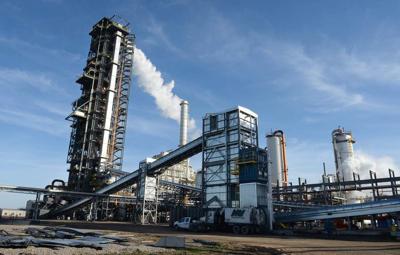ExxonMobil has signed a deal with Nucor Corp. to capture and transport up to 800,000 metric tons per year of carbon dioxide from Nucor’s iron plant in Convent to an ExxonMobil-owned site in Vermilion Parish.
That's the same location where ExxonMobil also plans to sequester carbon emissions from a CF Industries plant in Donaldsonville.
The ExxonMobil-Nucor sequestration project is scheduled to be up and running by 2026, company officials said Thursday. The iron plant is located off La. 3125 in St. James Parish, just down the road from the La. 70 intersection.
The 800,000 tons of carbon dioxide would represent roughly 73% of the more than 1.09 million tons the Nucor plant emitted in 2021, according to the latest available data from the Environmental Protection Agency.
It is also equivalent to about 178,000 gasoline-powered cars running for one year, according to EPA estimates. Louisiana had 3.77 million registered vehicles as of February, according to the latest U.S. Department of Transportation data.
For comparison, CF Industries’ Donaldsonville ammonia complex was the state’s top greenhouse gas emitter at more than 10 million tons in 2019, according to LSU’s latest greenhouse gas inventory. ExxonMobil’s Baton Rouge refinery was second with 6.36 million tons. The Nucor plant’s 2019 total of 978,000 tons wasn’t in the list’s top 20.
ExxonMobil’s pact with Nucor is its third carbon capture announcement in seven months, including the CF Industries agreement. The energy giant revealed a similar offtake agreement in April for Linde’s forthcoming hydrogen plant in Beaumont, Texas.
“Our agreement with Nucor is the latest example of how we’re delivering on our mission to help accelerate the world's path to net zero and build a compelling new business,” Dan Ammann, president of ExxonMobil Low Carbon Solutions, said in a statement.
For the CF Industries project, ExxonMobil will capture up to 2 million tons, or roughly one-fifth, of the Donaldsonville plant’s annual carbon dioxide emissions and ship them to Vermilion Parish via EnLink Midstream pipelines. That development is scheduled to be operational by 2025.
ExxonMobil officials have declined to offer specifics on the location of the Vermilion Parish site, other than acknowledging some of the acreage is “in and around” Pecan Island, because the exact injection location within the company’s 125,000-acre plot has not been determined.
Maps from the Vermilion Parish Assessor’s website shows ExxonMobil owns 15 parcels near the northeast corner of White Lake, not far from La. 82. Pecan Island is near the southern shore of White Lake.
Carbon capture has emerged as a political and environmental flashpoint in Louisiana. Uproar over a proposed sequestration well in Livingston Parish near Lake Maurepas, tied to Air Products’ proposed “blue” hydrogen plant in Ascension Parish, led to a slew of bills aimed at slowing down the project. Those bills were ultimately killed.
Meanwhile, the EPA announced in April it has taken a step toward allowing Louisiana to regulate its carbon capture injection wells, which likely would shorten permitting reviews for the wells. The move garnered praise from state officials industry supporters and condemnation from environmental advocates.
Industry advocates and Gov. John Bel Edwards have offered their full-throated support for carbon capture, calling it a necessary tool to reduce the state’s greenhouse gas emissions while maintaining Louisiana’s energy sector.
However, environmental advocates have decried carbon capture as a way to prop up a sagging fossil fuel industry, and they’ve questioned the effectiveness of the technology.
Louisiana is “putting the cart before the horse” by investing so much in unproven carbon capture technology, said Matt Rota, senior policy director at Healthy Gulf.
Rota said Louisiana’s subsurface is “already Swiss cheese” from decades of oil and gas drilling. Further drilling and sequestration could increase the amount of gaps in Louisiana’s geology and allow any carbon dioxide to escape.
“This is just moving too fast, and that this really just an attempt for the petrochemical and oil and gas industries to maintain their stranglehold on Louisiana,” he said.

